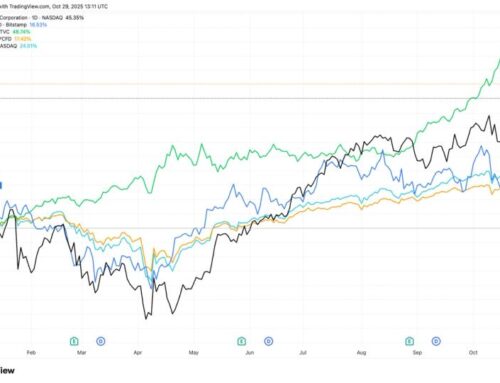Will Ethereum Outperform Bitcoin In 2026?
October 29, 2025
Ethereum’s impressive 120% rise over the past six months, reaching approximately $4,000, has significantly eclipsed Bitcoin’s modest 20% increase during this timeframe. This isn’t merely a fleeting moment—various fundamental factors indicate that ETH might sustain its outperformance trajectory.
Before we explore the specifics, if you’re interested in an upside with less volatility compared to holding a single stock or token like ETH or BTC, consider the High Quality Portfolio. It has thoroughly outperformed its benchmark—a mix of the S&P 500, Russell, and S&P MidCap indices—and has secured returns surpassing 105% since its inception. Why is this the case? As a collective, HQ Portfolio stocks have delivered superior returns with reduced risk compared to the benchmark index; less of a roller-coaster experience, as seen in HQ Portfolio performance metrics.
Why Ethereum Has the Edge
- Institutional Money: To begin with, institutional money is finally taking notice. Spot Ethereum ETFs have experienced significant inflows of around $13 billion, showcasing that traditional finance is welcoming ETH beyond Bitcoin. Major institutions such as BlackRock, Fidelity, and JPMorgan are now offering crypto products, and Ethereum’s utility-driven narrative resonates with sophisticated investors who recognize its role as the foundation of DeFi and Web3.
- Utility: You might question what distinguishes Ethereum from Bitcoin as an investment. While Bitcoin mainly functions as digital gold, Ethereum acts as a programmable platform producing real economic activity. The network manages transactions for everything from DeFi protocols to NFT marketplaces, generating authentic utility that underpins demand. This is not merely speculation—it represents infrastructure.
- Technical Upgrades: The forthcoming Fusaka upgrade in December 2025 is expected to offer substantial enhancements in speed and efficiency, with some analysts predicting ETH could exceed $5,000 following its implementation. The Pectra upgrade has already boosted validator efficiency and network scalability. These aren’t just theoretical enhancements—they represent concrete improvements that increase Ethereum’s value as a platform. In fact, there exists the potential for ETH to exceed the $10,000 threshold.
- Deflationary Mechanism: In contrast to Bitcoin’s fixed supply cap, Ethereum burns transaction fees via EIP-1559, rendering it deflationary during periods of heightened network activity. As demand for Ethereum-based applications rises, more ETH is permanently taken out of circulation, resulting in scarcity. While Bitcoin’s scarcity is fixed and assured by its hard cap, Ethereum’s scarcity is flexible and contingent on network use.
- Treasury Accumulation: Increasingly, large DAOs and institutions are holding ETH as a treasury asset, which reduces circulating supply and establishes prolonged buying pressure. Digital Asset Treasury companies, such as BitMine Immersion Technologies and SharpLink Gaming, now collectively own approximately 5% of the total ETH in circulation, and ETH’s added utility offers various reasons for institutions to retain it beyond merely being a store of value.… Related – BitMine Immersion’s Path To 2x Growth.
Risks to Consider
- Volatility Concerns: Ethereum displays greater volatility than Bitcoin, potentially offering greater rewards but also posing more risks during market declines. Recent trading in October illustrates how ETH can fluctuate from $4,700 to $3,800 within weeks, highlighting the significant price volatility investors must endure. Additionally, see – How XRP Price Falls To $1?
- Technical Vulnerabilities: The complexity of Ethereum introduces additional risk factors that Bitcoin’s simpler structure sidesteps. Smart contract bugs, liquid staking token failures, or validator issues could lead to system-wide complications. The 2016 DAO exploit that resulted in the creation of Ethereum Classic serves as a reminder that technical failures can have serious repercussions.
- ETH Sensitivity: Ethereum demonstrates acute responsiveness to macroeconomic influences and shifts in risk appetite. Recent ETF outflows of $389 million in a single month (September 2025) reveal how rapidly institutional sentiment can change, potentially exacerbating downside movements. Bitcoin’s “digital gold” narrative offers more stability during turbulent times. Although Bitcoin also experienced significant outflows in September, its overall price trend was much more favorable compared to Ethereum.
- Regulatory Uncertainty: Ethereum’s smart contract functionalities and DeFi ecosystem may encounter more regulatory scrutiny than Bitcoin’s simpler payment framework. Changes in regulators’ perspectives regarding programmable blockchains could profoundly influence ETH’s value proposition.
Investing in a single stock or token without thorough analysis can be risky. Consider the Trefis Reinforced Value (RV) Portfolio, which has outperformed its all-cap stocks benchmark (a combination of the S&P 500, S&P mid-cap, and Russell 2000 benchmark indices), delivering robust returns for investors. Why is this the situation? The quarterly rebalanced mix of large-, mid-, and small-cap RV Portfolio stocks has offered a responsive approach to maximize gains during optimistic market conditions while minimizing losses when markets decline, as detailed in RV Portfolio performance metrics.
The Bottom Line
Ethereum’s superior performance indicates genuine fundamental advantages: the adoption of institutional ETFs, upcoming technical enhancements, deflationary tokenomics, and its foundational role in the expanding DeFi ecosystem. The December Fusaka upgrade and ongoing institutional accumulation imply that this trend might continue well into 2026. Nevertheless, investors need to balance ETH’s higher reward potential with its elevated volatility and technical complexity.
Search
RECENT PRESS RELEASES
Related Post




